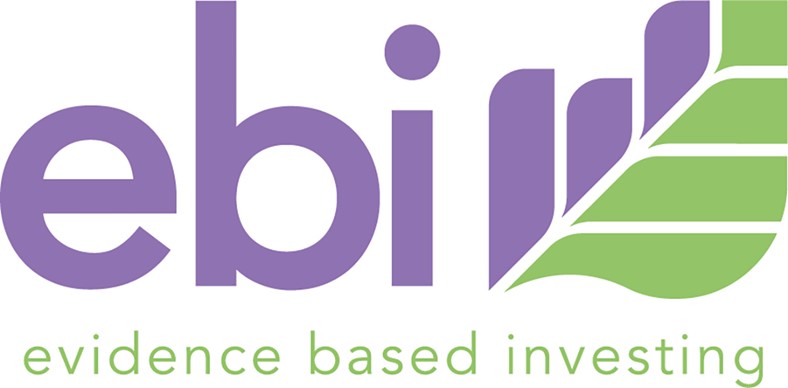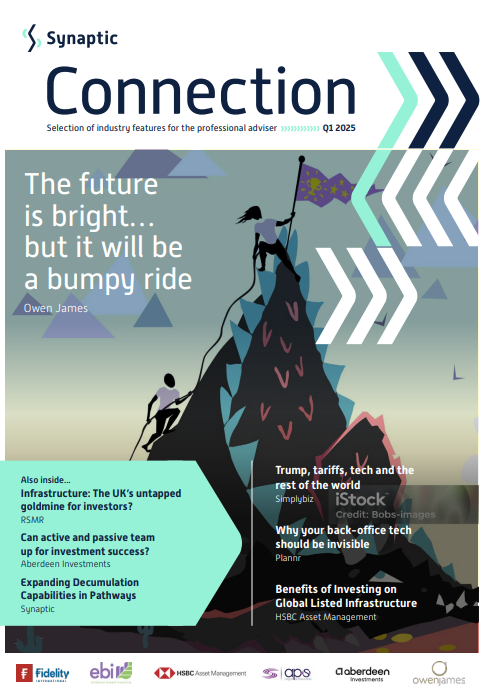In this edition...
- The future is bright for financial advice… but it will be a bumpy ride James Goad, Managing Director - Owen James
- Trump, tariffs, tech, and the rest of the world Fabian Wiesner, Head of Distribution Partnerships - Simplybiz
- Infrastructure: The UK’s untapped goldmine for investors? Katie Sykes, Client Engagement & Marketing Manager - RSMR
- The regulatory landscape for 2025 Sandy McGregor, Director of Policy - Simplybiz
- Can active and passive team up for investment success? Nick Millington, Head of Systematic Index Solutions - Aberdeen Investments
- Why your back-office tech should be invisible Abi Hortin, Implementation Specialist - Plannr Technologies Limited
- 2025 Planning and beyond… Scarlet Musson, Business Development Director - APS Legal Associates
- Marking 10 years of Multi-Asset Income BNY Investments,
- Trump, hitting the ground running Jonathan Griffiths, CFA Investment Product Manager - ebi Portfolios
- Weak UK outlook calls for nuanced approach Caroline Shaw, Portfolio Manager - Fidelity International
- Managing CGT through unitised funds Antony Champion, Managing Director, Head of Intermediaries - RBC Brewin Dolphin
- Expanding Decumulation Capabilities in Pathways Seb Marshall, Product Manager - Synaptic
- DFM due diligence and the role of financial strength consideration Matt Ward, Communications Director - AKG Financial Analytics Ltd
- Benefits of Investing on Global Listed Infrastructure Giuseppe Corona, Head of Listed Real Assets - HSBC Asset Management
- Taking stock of the new world order Ariel Bazalel, Investment Manager - Jupiter Strategic Bond Fund
 As we stand back and assess the situation following Donald Trump being inaugurated as the 47th President of the United States (US), it’s clear that we aren’t short of developments to analyse.
As we stand back and assess the situation following Donald Trump being inaugurated as the 47th President of the United States (US), it’s clear that we aren’t short of developments to analyse.
As expected, Trump hit the ground running - issuing a flurry of executive orders across a wide range of areas. In this piece we seek to unpick a handful of the key actions from Trump’s initial time in office, broken down across several themes.
Tariffs and global trade
Having indicated as such on the campaign trail, Trump has taken an aggressive approach towards tariffs and global trade, with his actions including imposing an additional 10% tariff on goods from China.
China subsequently announced counter-tariffs of 10-15% on US liquefied natural gas, coal, crude oil and farm equipment, as well as tariffs on some car exports and controls on the export of rare metals, raising concerns regarding the emergence of a global tariff war
While the long-term impacts are impossible to accurately predict at this point in time, there is no doubt that we have entered a new chapter of global trade, one geared more towards protectionism rather than open markets (only heightened by Trump’s aggressive stance towards geopolitically significant areas such as Greenland and the Panama canal), with the inherent zero-sum nature of this approach likely to create clear winners and losers as the economic impacts bite.
The ‘3-3-3’ Economic Growth Plan
Having recently been confirmed by the Senate, Trump’s Treasury Secretary Scott Bessent’s broad economic objectives for the US can now be brought into closer focus. A veteran hedge fund manager (who once headed George Soros’ family office), Bessent is no stranger to the challenges faced by highly indebted nations, most notably Japan, and the ‘three arrows’ policies delivered by late Japanese Prime Minister Shinzo Abe, which sought to navigate the Japanese economy through turbulent times.
Bessent has designed his own three arrows for the US, the ‘3-3-3’ plan, which can broadly be stated as follows:
- Raise US real GDP growth to 3% a year (up from c.2% currently, for example through tax cuts, deregulation, lower energy costs, and the reshoring of US manufacturing jobs) .
- Cut the annual budget deficit to 3% of GDP by the end of Trump’s four-year term (down from over 6% currently) .
- Increase US energy production by 3 million barrels per day equivalent (with other non-oil energy sources being a potential source of energy production increase for this goal).
The objective of this plan is to deliver non-inflationary growth, while also curbing the US’ fiscal deficit. While many have been quick to criticise Trump and his economic plans, suggesting he simply isn’t fit to hold the most important office of the world, other financials commentators have noted the wisdom of Trump appointing Bessent to the role of Treasury Secretary, with Bessent’s strategy (as outlined above) having the potential to be positive for the wider economy and risk assets, if implemented well.
Climate change and sustainable investing
On the campaign trail Trump was clear in relation to his confrontational stance to the environmentalist cause, with his “drill baby drill” catchphrase a core part of his repertoire, used as a way of energising his voter base, in part located within fossil fuel-dependent states in the South of the US. As he entered office Trump carried out a number of initial actions in support of this agenda, including pulling out of the Paris Agreement (for the second time), as well as seeking to unpick Joe Biden’s Green New Deal, including announcing a moratorium on offshore wind farm projects.
While there are clear headwinds in the US resulting from Trump’s agenda, we do not believe this impacts the ESG and sustainable investment agenda to the extent to which some media articles make the case for. While the US is the dominant power in the world, this power is gradually fading, with both the rise of the BRICs nations, and the European countries still holding relevance in a global landscape. Notably, we believe the US’s hand is perhaps weaker than its leaders currently believe, with China having replaced it as a primary trading partner for many countries around the world. These threats (such as tariffs, outlined as above) may have the effect of pushing countries further into the trading arms of China, and away from the US, only weakening the US’s status further.
In light of this, we do not expect a widespread shift away from sustainable investment globally. Supporting this are the clear scientific realities regarding environmental degradation and climate breakdown, that are becoming more apparent by the year. To follow an “anti-green” approach is to believe that countries across the world will not seek to address our failing environmental support systems, but instead will seek to switch back towards the fossil fuel agenda, accelerating the breakdown processes that are already in place. We simply do not believe this is feasible at a global scale (even if feasible in the short term, within the US), but instead believe that governments and regulators around the world will continue to move in the direction of travel given the underlying scientific realities at play - moving towards a lower carbon, more sustainable future.
Artificial Intelligence
Another area Trump has been active in during his first days in office, is Artificial Intelligence (AI). The growing trend of AI has been clear, both the technological development, particularly around Large Language Models (LLMs) such as Open AI’s ChatGPT and the advanced chips (for example from NVIDIA) supporting them, as well as the financial markets impact, as AI-related stocks in the US drove stock market returns once again over 2024.
Building on this, one of Trump’s early announcements included ‘Stargate’ - a new joint venture investing up to $500bn into AI-related infrastructure, by a new partnership formed by tech companies OpenAI, Oracle, and SoftBank. This announcement demonstrated Trump’s commitment to this area, and his belief that the rapidly growing industry will be one of the core engines of the US economy in the coming years.
Conclusion
Trump has truly hit the ground running - beginning to deploy his agenda with a pace and ferociousness that has been a sight to behold, but disorientating for some.
Given the pace of change, and some of the new structures that are emerging (most notably the expansion of Tariff’s as a primary weapon of trade), it is fair to say that the election of Trump for a second term has been a true fork in the road for the US, and as a result the global economy.
Trump’s agenda is undoubtedly divisive, with his supporters elated as he enacts a range of policies as promised on the campaign trail, while his detractors look on aghast, with the global ‘rules-based order’ seemingly collapsing in front of their eyes.
We think the reality is somewhere in the middle - while we disagree with Trump on a range of issues (most notably around the environment and climate change), we can also appreciate the objectives of the Trump administration and the goals they are seeking to achieve over the coming four years.
Nonetheless what is clear is that the journey is just beginning, and it’s going to be a bumpy ride. As such, as the year progresses, we hope readers are seated comfortably with seatbelts fastened, as we all seek to digest the evolving world order that is playing out in front of our eyes.
Get in touch:
www.ebi.co.uk
01922 472 226
enquiries@ebi.co.uk
Sign up for updates
Keep up to speed with everything you need to know each quarter, by email or post.


